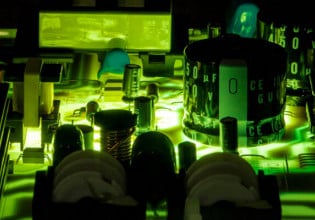ABB Adds New Class 2 Combiners to its Power Express Family
The fresh two and four–circuit combiners offer tailored central power extension solutions without conduits, ABB says, and can be installed sans the expertise of a licensed electrician.
Introduced this Tuesday, ABB’s new Power Express combiners are compatible with either two or four Class 1 inputs of -42 to -60V DC and provide respective Class 2 outputs of -54 V at either 150 or 300 W.

ABB’s Power Express combiner. Image used courtesy of ABB
Per ABB’s announcement release, the combiners serve to provide safe and effective remote powering for indoor loads that exceed the capabilities of a single Class 2 circuit. They join a previous eight-circuit, 600 W device in the Power Express family, and offer flexible options to meet users’ unique needs while complying with national electric code (NEC) requirements, the company said.
What are Class 1 and Class 2 Circuits?
A Class 1 circuit provides any amount of energy at potentials greater than 60 V. Cabling to handle this amount of power can only be installed by a licensed electrician.
A Class 2 circuit delivers 100 W or less at voltages under 60 V. No power conduits are required, and the installer of the appropriate power lines needs no special licensing. As such, users of low-power subsystems can more flexibly rearrange layouts or capabilities without the need for the expensive, time-consuming electrical contracting that would otherwise be required.
The Power Express Product Line
Solara Technical, which describes itself as a value-added reseller of power solutions and a partner to ABB, presented a helpful video describing ABB’s Power Express product line early last year.
As described, the line as a whole can first convert high power Class 1 circuits to low-power (less than 100 W) Class 2 circuits. If necessary, it can also recombine the individual Class 1 outputs on the other end into a higher power rail.
One device supplying Class 1 power may have four modules, with each module providing eight 100-watt circuits for a total of 32.

ABB's Power Express shelves provide Class 1 outputs. Image used courtesy of ABB
The shelves are qualified to the NEC Class 2 rating, allowing for power cabling to be deployed in a data cable raceway instead of a conduit.
The units are designed to support an alarm card for stand-alone deployment, ABB says, and can be uplinked over an RS-485 data bus attached via the RJ-45 connection on the rear of the shelf. This uplink allows each shelf to interface with a Pulsar Plus controller, a device often used in ABB power systems; this feature enables local access, alarming, and control of each circuit in every shelf.
And the combiners are purposed, naturally, to recombination. Engineers can feed the components with a number of remote Class 1 outputs to be coupled back into more powerful Class 1 circuits at the other end, if needed.
Galvanic Isolation
ABB’s Power Express combiners provide galvanic isolation between Class 1 inputs while connecting them in parallel, offering operators assurance that NEC requirements are met when powering larger loads, the company said. All three members of the product line also reduce the possibility of user error by internally fusing the circuits within the module, ABB noted.
Extending an Established Product Line
In line with their eight-circuit predecessor, ABB’s new two and four–circuit combiners are fed by multiple 100-watt Class 1 inputs and combine them to power a single Class 2 output at a nominal 48 V. The compact units are 1 rack unit (RU) high and 6 inches wide.
The rack unit, a standard measurement for servers and other network equipment, is 1.75 inches. As such, these small units offer a space-conscious solution to users whose power needs fall between 150 and 300 W.
Applications
Per Raj Radjassamy, 5G and wireless segment leader for ABB Power Conversion, these combiners will help companies employ combined Class 2 circuitry in infrastructure supporting 5G and Wi-Fi hotspots, fiber applications, distributed antenna systems (DAS), and security cameras.






